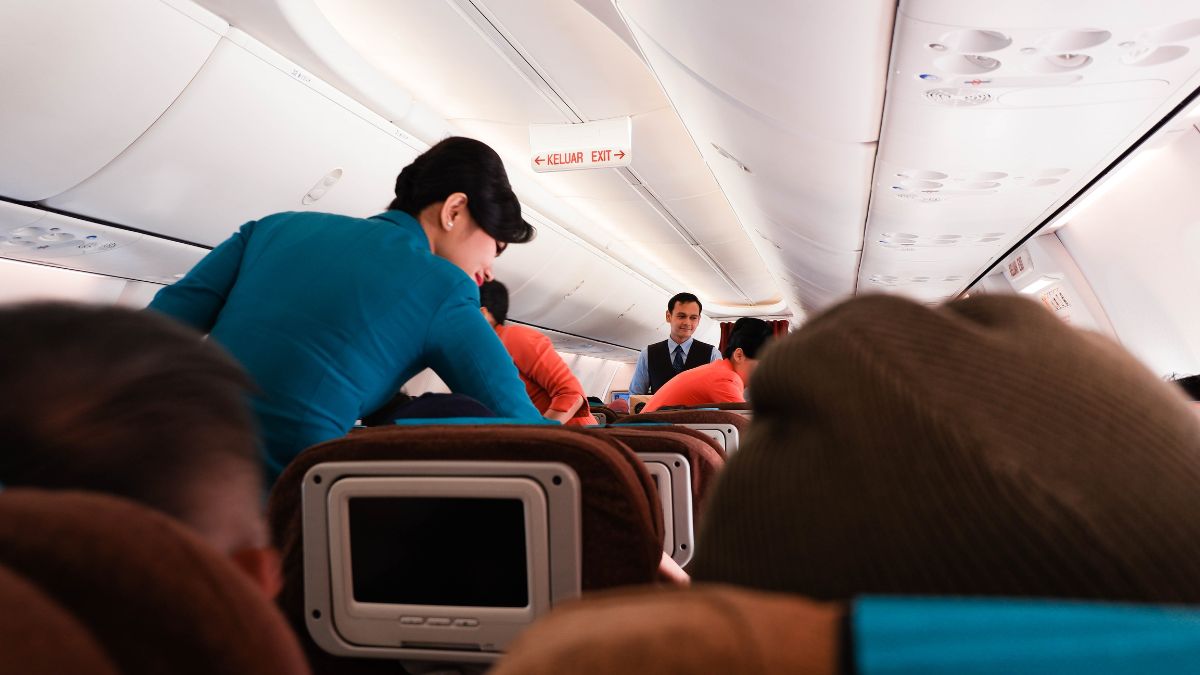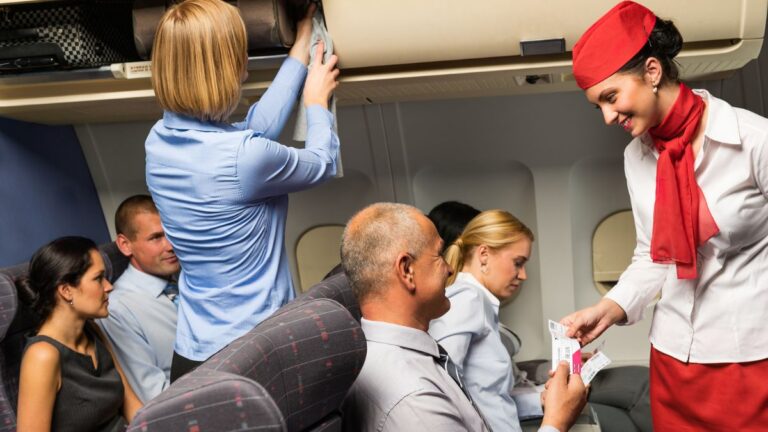Do Airlines Hire Plus Size Cabin Crew? Breaking Stereotypes and Embracing Diversity in the Skies

As participants in Amazon Associates and other programs, we earn from qualifying purchases. This comes at no additional cost to you. For more details, see our Affiliate Disclosure.
The question of whether airlines hire plus size cabin crew is complex, as it depends on the country and airline. In the United States, there are flight attendants of all sizes working for major airlines, while in East Asian countries, cultural attitudes towards weight can make it more difficult for plus size applicants.
This article will explore the issue of hiring plus size cabin crew and promoting diversity in the skies.
Exploring the Stereotypes: A Historical Perspective on Cabin Crew Selection
Since the inception of commercial air travel, airlines have sought to project a glamorous and polished image. In the early days, this translated to very specific recruitment criteria for cabin crew, particularly flight attendants. These requirements were shaped by societal norms and stereotypes about appearance, gender, age, and yes, size.
Historically, flight attendants were expected to be young, attractive, single women who were required to meet rigid physical standards. This included specific height, weight, and often even bust-waist-hip measurements. Airlines often justified these requirements by citing the physical demands of the job and the need for cabin crew to move swiftly and smoothly in the tight confines of an aircraft.
However, this ostensibly pragmatic rationale glossed over the fact that these criteria were also based on societal expectations and beauty norms of the time. The image of the slim, stylishly dressed, and impeccably groomed flight attendant was marketed as an integral part of the glamorous and exclusive experience of air travel.
This approach to cabin crew selection was further bolstered by advertising campaigns that objectified and sexualized flight attendants. For instance, in the 1960s and 70s, airlines in the U.S ran infamous ad campaigns with slogans such as “Fly Me” or “I’m Cheryl, Fly Me”, presenting flight attendants as part of the allure of flying.
The selection and marketing of cabin crew based on physical appearance was not just confined to the United States. International airlines also adopted similar practices. For instance, airlines in Asia have been known for their stringent selection procedures, which often include specific requirements for body size and proportion.
Thankfully, this narrative has been progressively challenged over the years. While the industry has taken significant strides towards inclusivity, remnants of these stereotypes still persist. The journey to breaking these stereotypes is slow but significant, reflecting wider societal shifts towards body positivity and size diversity.
Redefining the Ideal: Understanding Body Positivity and Size Inclusivity
The concept of the ‘ideal’ body has evolved significantly over the decades, as society has come to recognize that beauty and capability are not confined to specific measurements or proportions. This evolving viewpoint is a product of the broader body positivity movement, which advocates for acceptance, appreciation, and respect for all bodies, irrespective of size, shape, age, or appearance.
Body positivity has its roots in the fat acceptance movement that emerged in the late 1960s, in response to prevalent fat-shaming and discrimination. Over time, this movement has grown and evolved, focusing not just on larger bodies, but all bodies that deviate from traditional beauty standards. It emphasizes the inherent worth and dignity of every individual, rejecting the idea that a person’s value is tied to their physical appearance.
Closely related to the body positivity movement is the concept of size inclusivity. This recognizes that individuals of all sizes have the right to be represented, respected, and catered for in all aspects of society. In the context of the airline industry, size inclusivity means acknowledging that flight attendants come in all shapes and sizes, and that their ability to perform their duties is not inherently linked to their size.
This progressive redefinition of the ‘ideal’ body is challenging industries worldwide to reconsider their norms and standards. The fashion industry, for example, has seen an increasing number of plus size models on runways and in advertising campaigns. Similarly, the fitness industry is beginning to feature more diverse body types in its representation.
In the airline industry, this shift towards body positivity and size inclusivity is gradually changing the landscape of cabin crew selection. Airlines are beginning to recognize that it is the skills, capabilities, and customer service aptitude of their flight attendants that truly matter, rather than their physical appearance or size. This shift not only provides opportunities for a more diverse range of individuals to become flight attendants, but it also reflects and caters to the diversity of the passengers they serve.
Airline Recruitment Policies: An Analysis Across Major Carriers
As societal norms and perspectives have evolved, major airlines have begun to adjust their recruitment policies to reflect these changes. Though there is still room for improvement, a noticeable shift towards more inclusive hiring practices can be seen in many of the world’s leading carriers.
- Delta Airlines: While Delta’s initial hiring policies once revolved around strict weight and height standards, these requirements have become far less rigid over the years. Today, the airline emphasizes the ability to perform job-related functions, such as reaching overhead bins and fitting through the aisle, over specific physical attributes.
- American Airlines: American Airlines was one of the first to break away from restrictive weight limits in the late 20th century. The current recruitment guidelines focus on height—due to safety requirements regarding reach—but do not mention weight, reflecting a shift towards performance ability rather than physical appearance.
- Emirates: Though known for its rigorous selection process, Emirates has demonstrated a commitment to diversity and inclusion. They state that they employ cabin crew from over 160 countries and that their team is as diverse as the customers they serve. Their current requirements emphasize the ability to reach 212 cm without shoes, rather than specifying a weight limit.
- Qantas: This Australian carrier is another airline that has moved away from specific weight requirements. The current guidelines stress that prospective crew members must be able to conduct safety-related tasks and be of good physical health, but they do not outline any weight specifications.
- British Airways: British Airways has also updated its hiring criteria, focusing on height and reach ability to ensure safety procedures can be met. They do not stipulate a weight requirement for cabin crew candidates.
- Lufthansa: The German carrier has similarly updated its requirements to stress physical fitness and the ability to swim, without mentioning weight. The airline’s cabin crew recruitment process is centered around personality, customer service skills, and linguistic abilities.
While it’s clear progress is being made, it’s essential to note that these changes in recruitment policy do not automatically translate to fully inclusive practices. Implicit bias and societal pressures can still impact hiring decisions. Plus size cabin crew representation remains noticeably low in many airlines, suggesting there is still a long way to go. It is up to these carriers and others to continue evolving and advocating for true diversity and inclusion in the skies.
Voices of the Unheard: Real-Life Experiences of Plus Size Flight Attendants
As we dissect the issue of size inclusivity in the airline industry, it’s crucial to turn our attention to the individuals most directly affected – plus size flight attendants. Their experiences, both positive and negative, illuminate the reality behind the policies and help us understand the steps that still need to be taken towards genuine inclusivity.
- Overcoming Obstacles: Many plus size cabin crew members share stories of overcoming bias and prejudice during the recruitment process. Despite having the necessary qualifications and skills, they often find themselves working twice as hard to prove their competence and ability to handle the physical demands of the job.
- Dealing with Stereotypes: Even after being hired, plus size flight attendants frequently confront stereotypes and misconceptions from both colleagues and passengers. These range from assumptions about their physical capabilities to judgment about their appearance. Many use these encounters as opportunities to educate others and break down stereotypes.
- Advocating for Change: The struggles faced by plus size flight attendants have given rise to advocates pushing for systemic change in the industry. These individuals use their platforms to speak out about size discrimination, encouraging airlines to ensure their hiring practices are fair, transparent, and free from bias.
- Stories of Success: Despite the challenges, there are many stories of plus size flight attendants who have thrived in their roles. They are living proof that the ability to provide excellent service, ensure passenger safety, and create a welcoming atmosphere on board has nothing to do with size. These success stories serve as inspiration for others and contribute to breaking down the barriers in the industry.
- The Power of Representation: Plus size flight attendants emphasize the importance of representation in the cabin crew. Seeing individuals who look like them in these roles not only provides encouragement for prospective flight attendants but also helps to normalize size diversity for passengers.
In sum, the experiences of plus size flight attendants underscore the importance of continuing to promote size inclusivity in the airline industry. While strides have been made, their stories remind us that there is still significant work to be done to ensure equality and acceptance in the skies.
The Impact of Size Diversity on Passenger Experience
The impact of size diversity among cabin crew extends beyond the crew themselves, significantly influencing the passenger experience. When passengers see themselves represented in the cabin crew, it fosters a sense of inclusion and acceptance that can transform the dynamics of air travel. Here’s how size diversity among flight attendants can enhance the passenger experience:
1. Fostering an Inclusive Environment: Seeing plus size cabin crew can be an affirming experience for plus size passengers, fostering a sense of belonging and acceptance. It sends a powerful message that airlines value all passengers, regardless of size.
2. Breaking Down Stereotypes: Size diversity in the cabin crew helps challenge and dismantle prevailing stereotypes about size and ability. This can lead to more understanding and less judgment, cultivating a more compassionate and accepting society overall.
3. Providing Comfort and Reassurance: Plus size passengers often experience discomfort and anxiety while traveling due to factors like narrow airplane seats and seatbelt extenders. Having plus size cabin crew members who understand these challenges firsthand can provide a layer of comfort and reassurance.
4. Encouraging Dialogue and Understanding: When airlines embrace size diversity in their cabin crew, it opens up opportunities for conversations about body positivity and inclusivity. It gives passengers a chance to broaden their perspectives and foster empathy.
5. Enhancing Customer Service: Diversity in the cabin crew can lead to more empathetic and personalized customer service. Flight attendants who represent a range of body sizes are more likely to understand the needs and experiences of a diverse passenger group, thereby improving the overall passenger experience.
Size diversity among cabin crew plays a pivotal role in shaping the air travel experience. It has the potential to transform the industry from one that has traditionally been marked by exclusivity to one that truly celebrates diversity and inclusivity.
Legal Insights: Addressing Discrimination and Fostering Equality in Airline Hiring Practices
Legal frameworks and guidelines have played a significant role in addressing discrimination and fostering equality within airline hiring practices. A host of international, regional, and national laws have come into effect over the years, protecting individuals from workplace discrimination based on factors such as race, gender, age, and physical attributes.
- International Law: At the international level, The Universal Declaration of Human Rights (UDHR), adopted by the United Nations in 1948, provides a broad protection against discrimination. Article 23 states that “Everyone, without any discrimination, has the right to equal pay for equal work.”
- Regional Laws: At the regional level, The European Union’s Employment Equality Directive prohibits discrimination based on religion or belief, disability, age, or sexual orientation in the workplace, including in relation to recruitment. While this doesn’t explicitly address size discrimination, it does lay a foundation for inclusive and fair hiring practices.
- National Laws: National laws vary significantly. For example, in the United States, Title VII of the Civil Rights Act of 1964 prohibits employment discrimination based on race, color, religion, sex, or national origin. The Americans with Disabilities Act (ADA) also protects qualified individuals from discrimination based on disability. However, neither of these explicitly cover size or weight discrimination.
In the absence of explicit legal protection against size discrimination, flight attendants have turned to legal provisions addressing workplace safety and health, and the right to a non-hostile work environment. For instance, there have been lawsuits in which weight-based discrimination has been construed as sex discrimination, given that women are disproportionately affected by weight standards.
While existing laws have provided some avenues for addressing weight-based discrimination, they have their limitations. Advocacy groups are pushing for more explicit legal protections for plus-size individuals, similar to the protections against discrimination based on race, religion, age, and sex.
Global Snapshot: How Different Airlines Across the World are Embracing Size Diversity
Different airlines across the globe are progressively acknowledging the need for diversity and inclusion in their cabin crew recruitment, recognizing that an inclusive approach enhances their brand image, attracts a wider talent pool, and enriches the passenger experience.
- United Airlines (United States): United Airlines has actively taken steps towards a more inclusive and diverse approach in its recruitment strategies. They have relaxed the once-stringent physical appearance requirements, emphasizing instead the ability of flight attendants to perform their duties effectively.
- Air India (India): Air India, one of the largest carriers in India, made headlines in 2016 when it decided to ground around 130 of its cabin crew members for failing to meet the company’s body mass index (BMI) standards. This action was met with substantial backlash. Since then, the company appears to have revised its stance, emphasizing the physical fitness and capability of cabin crew rather than rigid body standards.
- Air New Zealand (New Zealand): Air New Zealand is another carrier leading the charge towards more inclusive recruitment. They have removed specific weight requirements from their recruitment process and are known for their focus on diversity and inclusion.
- Ethiopian Airlines (Ethiopia): Ethiopian Airlines, Africa’s largest airline, has been recognized for its efforts in promoting diversity in its workforce. While their cabin crew selection still includes a focus on physical ability to meet the demands of the role, there are no specific weight restrictions, demonstrating a shift towards performance over appearance.
- Qatar Airways (Qatar): Qatar Airways has faced criticism in the past for its strict appearance-based regulations. However, more recently, the airline appears to be embracing changes in line with global trends towards inclusivity, moving away from specific weight guidelines.
While it’s encouraging to see these steps towards inclusivity, it’s important to note that progress varies significantly among different airlines and regions. The challenge for the airline industry going forward will be to ensure that this momentum towards diversity and inclusion continues, and that the skies become a place where everyone, regardless of size, can feel welcomed and represented.






